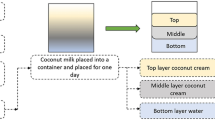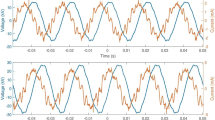Abstract
This work shows the convective drying kinetics of moringa seeds (Moringa oleifera L) at different drying temperatures 40, 50, 60, 70, and 80 °C and the effect drying on the extracted oil yield. Four simplified models were fitted to the kinetics data, and a phenomenological mathematical model (PMM) was developed to describe the process. The simplified model that better represented the experimental data was Verma, with a global relative mean error of 1.31%. The PMM with the use of an equilibrium boundary condition at the surface produced better results than those obtained when considering the convective condition, indicating that the effects of external mass transfer resistance are neglected. The moringa oil was extracted from all dried seeds conditions using different extraction techniques, such as Soxhlet technique, ultrasound-assisted, and mechanical extraction; and the maximum oil yield obtained for dry seeds was 43.06%, 31.53%, and 24.93% respectively. All drying temperatures of the moringa seed do not show influence the oil yield obtained in each extraction method used.






Similar content being viewed by others
References
Anwar F, Latif S, Ashraf M, Gilani AH (2007) Moringa oleifera: a food plant with multiple medicinal uses. Phytother Res 21:17–25. https://doi.org/10.1002/ptr.2023
Kooltheat N, Sranujit RP, Chumark P, Potup P, Laytragoon-Lewin N, Usuwanthim K (2014) An ethyl acetate fraction of Moringa oleifera Lam. Inhibits human macrophage cytokine production induced by cigarette smoke. Nutrient 6:697–710. https://doi.org/10.3390/nu6020697
Tiloke C, Anand K, Gengan RM, Chuturgoon AA (2018) Moringa oleifera and their phytonanoparticles: potential antiproliferative agents against cancer. Biomed Pharmacother 108:457–466. https://doi.org/10.1016/j.biopha.2018.09.060
Lin M, Zhang J, Chen X (2018) Bioactive flavonoids in Moringa oleifera and their health-promoting properties. J Funct Foods 47:469–479. https://doi.org/10.1016/j.jff.2018.06.011
Atabani AE, Mofijur M, Masjuki HH, Badruddin IA, Kalam MA, Chong WT (2014) Effect of Croton megalocarpus, Calophyllum inophyllum, Moringa oleifera, palm and coconut biodiesel–diesel blending on their physico-chemical properties. Ind Crop Prod 60:130–137. https://doi.org/10.1016/j.indcrop.2014.06.011
Tambone F, Pradella M, Bedussi F, Adani F (2019) Moringa oleifera Lam. as an energy crop for biogas production in developing countries. Biomass Convers Bior 10:1083–1089. https://doi.org/10.1007/s13399-019-00550-x
Paula HM, Oliveira Ilha MS, Sarmento AP, Andrade LS (2018) Dosage optimization of Moringa oleifera seed and traditional chemical coagulants solutions for concrete plant wastewater treatment. J Clean Prod 174:123–132. https://doi.org/10.1016/j.jclepro.2017.10.311
Real-Olvera J, Rustrian-Portilla E, Houbron E, Landa-Huerta FJ (2015) Adsorption of organic pollutants from slaughterhouse wastewater using powder of Moringa oleifera seeds as a natural coagulant. Desalin Water Treat 57:9971–9981. https://doi.org/10.1080/19443994.2015.1033479
Vieira AMS, Vieira MF, Silva GF, Araújo ÁA, Fagundes-Klen MR, Veit MT, Bergamasco R (2009) Use of Moringa oleifera seed as a natural adsorbent for wastewater treatment. Water Air Soil Pollut 206:273–281. https://doi.org/10.1007/s11270-009-0104-y
Villaseñor-Basulto DL, Astudillo-Sánchez PD, Real-Olvera J, Bandala ER (2018) Wastewater treatment using Moringa oleifera Lam seeds: a review. J Water Process Eng 23:151–164. https://doi.org/10.1016/j.jwpe.2018.03.017
Zhong J, Wang Y, Yang R, Liu X, Yang Q, Qin X (2018) The application of ultrasound and microwave to increase oil extraction from Moringa oleifera seeds. Ind Crop Prod 120:1–10. https://doi.org/10.1016/j.indcrop.2018.04.028
Bhutada PR, Jadhav AJ, Pinjari DV, Nemade PR, Jain RD (2016) Solvent assisted extraction of oil from Moringa oleifera Lam. seeds. Ind Crop Prod 82:74–80. https://doi.org/10.1016/j.indcrop.2015.12.004
Fakayode OA, Ajav EA (2016) Process optimization of mechanical oil expression from Moringa (Moringa oleifera) seeds. Ind Crop Prod 90:142–151. https://doi.org/10.1016/j.indcrop.2016.06.017
Thirugnanasambandham K (2017) Ultrasound-assisted extraction of oil from Moringa oleifera Lam. seed using various solvents. Energ Source Part A 40:343–350. https://doi.org/10.1080/15567036.2017.1416708
Rocha RP (2011) Influence of drying process on the quality of medicinal plants: a review. J Med Plant Res 5(33). https://doi.org/10.5897/JMPRX11.001
Scheufele FB, Ribeiro C, Módenes AN, Espinoza-Quiñones FR, Bergamasco R, Pereira NC (2015) Assessment of drying temperature of sugarcane bagasse on sorption of reactive blue 5G dye. Fiber Polym 16:1646–1656. https://doi.org/10.1007/s12221-015-5087-2
Aremu AK, Akintola A (2016) Drying kinetics of moringa (Moringa oleifera) seeds. J Life Sci Technol. https://doi.org/10.18178/jolst.4.1.7-10
Popoola LT, Giwa A, Aderibigbe TA (2018) Kinetics, optimization and proximate analysis of drying Moringa oleifera seeds in a tray dryer. Ind Chem 03(01). https://doi.org/10.4172/2469-9764.1000123
Omofoyewa MG, Popoola LT, Giwa A (2017) Optimization of drying parameters of moringa seeds in a tray dryer using Box-behnken technique of RSM. Int J Eng Res Afr 32:86–99. https://doi.org/10.4028/www.scientific.net/JERA.32.86
Avhad MR, Marchetti JM (2016) Mathematical modelling of the drying kinetics of Hass avocado seeds. Ind Crop Prod 91:76–87. https://doi.org/10.1016/j.indcrop.2016.06.035
Page GE (1949) Factors influencing the maximum rates of air drying shelled corn in thin layers. Purdue University, West Lafayette
Toğrul İT, Pehlivan D (2004) Modelling of thin layer drying kinetics of some fruits under open-air sun drying process. J Food Eng 65:413–425. https://doi.org/10.1016/j.jfoodeng.2004.02.001
Henderson SM (1974) Progress in developing the thin layer drying equation. Trans ASAE 17:1167–1168. https://doi.org/10.13031/2013.37052
Verma LR, Bucklin RA, Endan JB, Wratten FT (1985) Effects of drying air parameters on rice drying models. Trans ASAE 28:296–0301. https://doi.org/10.13031/2013.32245
Cruz FPB, Johann G, de Oliveira KC, Palú F, da Silva EA, Guirardello R, Curvelo Pereira N (2017) Crambe grain drying: Evaluation of a linear and double resistance driving force model and energetic performance. Renew Sust Energ Rev 80:1–8. https://doi.org/10.1016/j.rser.2017.05.170
Doymaz İ (2005) Drying behaviour of green beans. J Food Eng 69:161–165. https://doi.org/10.1016/j.jfoodeng.2004.08.009
AOCS (1998) Official methods and recommended practices of the American Oil Chemist’s Society. Method Cc 10c–95, 5th edn. AOCS, Champaign
Mohsenin NN (1986) Physical properties of plant and animal materials, 2nd edn. Gordon and Breach Science Publishers, New York
Moravec CM, Bradford K, Laca E (2008) Water relations of drumstick tree seed (Moringa oleifera): imbibition, desiccation, and sorption isotherms. Seed Sci Technol 36:311–324. https://doi.org/10.15258/sst.2008.36.2.05
Aviara NA, Ehiabhi S, Ajibola O, Oni S, Power P, Abbas T, Onuh O (2011) Effects of moisture content and temperature on the specific heat of Soya bean, Moringa oleifera seed and Mucuna flagellipes nut. Int J Agri Biol Eng 4:87–92. https://doi.org/10.3965/j.ijabe.2011.04.01.087-092
Ranz W, Marshall W (1952) Evaporation from drops. Chem Eng Prog 48:141–146
Mani S, Jaya S, Vadivambal R (2007) Optimization of solvent extraction of moringa (Moringa oleifera) seed kernel oil using response surface methodology. Food Bioprod Process 85:328–335. https://doi.org/10.1205/fbp07075
Menezes ML, Johann G, Diorio A, Pereira NC, Silva EA (2018) Phenomenological determination of mass transfer parameters of oil extraction from grape biomass waste. J Clean Prod 176:130e139. https://doi.org/10.1016/j.jclepro.2017.12.128
Johann G, Menezes ML, Pereira NC, Silva EA (2018) Assessment of pretreatment temperature on the oil extraction from the vinification waste. J Food Process Preserv:e13682. https://doi.org/10.1111/jfpp.13682
Vega A, Fito P, Andrés A, Lemus R (2007) Mathematical modeling of hot-air drying kinetics of red bell pepper (var. Lamuyo). J Food Eng 79:1460–1466. https://doi.org/10.1016/j.jfoodeng.2006.04.028
Doymaz I, Gorel O, Akgun NA (2004) Drying characteristics of the solid by-product of olive oil extraction. Biosyst Eng 88:213–219. https://doi.org/10.1016/j.biosystemseng.2004.03.003
Kaleemullah S, Kailappan R (2006) Modelling of thin-layer drying kinetics of red chillies. J Food Eng 76:531–537. https://doi.org/10.1016/j.jfoodeng.2005.05.049
Kashaninejad M, Mortazavi A, Safekordi A, Tabil LG (2007) Thin-layer drying characteristics and modeling of pistachio nuts. J Food Eng 78:98–108. https://doi.org/10.1016/j.jfoodeng.2005.09.007
Roberts JS, Kidd DR, Padilla-Zakour O (2008) Drying kinetics of grape seeds. J Food Eng 89:460–465. https://doi.org/10.1016/j.jfoodeng.2008.05.030
Aral S, Bese AV (2016) Convective drying of hawthorn fruit (Crataegus spp.): Effect of experimental parameters on drying kinetics, color, shrinkage, and rehydration capacity. Food Chem 210:577–584. https://doi.org/10.1016/j.foodchem.2016.04.128
Evin D (2012) Thin layer drying kinetics of Gundelia tournefortii L. Food Bioprod Process 90:323–332. https://doi.org/10.1016/j.fbp.2011.07.002
Aregbesola OA, Ogunsina BS, Sofolahan AE, Chime NN (2015) Mathematical modeling of thin layer drying characteristics of dika (Irvingia gabonensis) nuts and kernels. Nigerian Food J 33:83–89. https://doi.org/10.1016/j.nifoj.2015.04.012
Perea-Flores MJ, Garibay-Febles V, Chanona-Pérez JJ, Calderón-Domínguez G, Méndez-Méndez JV, Palacios-González E, Gutiérrez-López GF (2012) Mathematical modelling of castor oil seeds (Ricinus communis) drying kinetics in fluidized bed at high temperatures. Ind Crop Prod 38:64–71. https://doi.org/10.1016/j.indcrop.2012.01.008
Johann G, Menezes ML, Pereira NC, Silva EA (2016) Comparing models to Neumann and Dirichlet conditions in grape seed drying. Appl Therm Eng 93:865–871. https://doi.org/10.1016/j.applthermaleng.2015.10.005
Mercier S (2019) Contribution of external resistance to mass transfer during pasta drying. Dry Technol 37:59–68. https://doi.org/10.1080/07373937.2018.1437546
Rovedo CO, Aguerre RJ, Suarez C (1993) Moisture diffusivities of sunflower seed components. Int J Food Sci Technol 28:159–168. https://doi.org/10.1111/j.1365-2621.1993.tb01261.x
Ciro-Velásquez H, Cano L, Perez Alegría L (2010) Numerical simulation of thin layer coffee drying by control volumes. Dyna revfacnacminas [online] 77:270–278 ISSN 0012-7353
Silva WP, Silva CMDPS, Silva DDPS, Araújo Neves G, Lima AGB (2010) Mass and heat transfer study in solids of revolution via numerical simulations using finite volume method and generalized coordinates for the Cauchy boundary condition. Int J Heat Mass Transf 53:1183–1194. https://doi.org/10.1016/j.ijheatmasstransfer.2009.10.028
Yang W, Sokhansanj S, Tang J, Winter P (2002) Determination of thermal conductivity, specific heat and thermal diffusivity of borage seeds. Biosyst Eng 82:169–176
Posom J, Sirisomboon P (2014) Evaluation of the thermal properties of Jatropha curcas L. kernels using near-infrared spectroscopy. Biosyst Eng 125:45–53. https://doi.org/10.1016/j.biosystemseng.2014.06.011
Aviara NA, Ogunjimi L (2008) Thermal properties of Guna seeds. Int Agro physics 22:29–297
Bamgboye AI, Adejumo OI (2010) Thermal properties of roselle seed. Int Agrophysic 24:85–87
Rebey I, Bourgou S, Sofiene BK, AidiWannes W, Riadh K, Tounsi M, Fauconnier M-L (2019) On the effect of initial drying techniques on essential oil composition, phenolic compound and antioxidant properties of anise (Pimpinella anisum L.) seeds. J Food Meas Charact. https://doi.org/10.1007/s11694-019-00284-4
Radünz LL, Melo EC, Martins PM, Santos RHS, Santos RR, Machado MC (2002) Secagem de alecrim pimenta (Lippia sidoides Cham.) em secador de leito fixo. Rev Bras Plant Med 5:79–82
Routray W, Dave D, Ramakrishnan VV, Murphy W (2017) Study of drying kinetics of salmon processing by-products at different temperatures and the quality of extracted fish oil. Dry Technol 35:1981–1993. https://doi.org/10.1080/07373937.2017.1293684
Gutiérrez L-F, Ratti C, Belkacemi K (2008) Effects of drying method on the extraction yields and quality of oils from quebec sea buckthorn (Hippophaërhamnoides L.) seeds and pulp. Food Chem 106:896–904. https://doi.org/10.1016/j.foodchem.2007.06.058
Acknowledgments
The authors are thankful to CAPES (Coordination for the Improvement of Higher Education Personnel), CNPq (National Counsel of Technological and Scientific Development, (Gredson Keiff Souza, Process no. 150602/2019-7)), and to the Complex of Research Support Centers (COMCAP/UEM) for the support in the analysis.
Author information
Authors and Affiliations
Corresponding authors
Ethics declarations
Conflict of interest
The authors declare that they have no conflict of interest
Additional information
Publisher’s Note
Springer Nature remains neutral with regard to jurisdictional claims in published maps and institutional affiliations.
Rights and permissions
About this article
Cite this article
de Almeida, F.N.C., Johann, G., Siqueira, N.W. et al. Convective drying of Moringa oleifera seeds: kinetics modelling and effects on oil yield from different extraction techniques. Biomass Conv. Bioref. 12, 3197–3208 (2022). https://doi.org/10.1007/s13399-020-01198-8
Received:
Revised:
Accepted:
Published:
Issue Date:
DOI: https://doi.org/10.1007/s13399-020-01198-8




